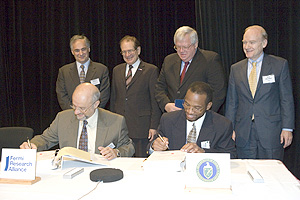DOE selects Fermi Research Alliance to operate Fermilab, as its scientists continue pursuits in particle physics
By Steve KoppesNews Office
 Officials gathered at Fermi National Accelerator Laboratory Wednesday, Nov. 1, for the signing of the contract to operate Fermilab. Representing the Fermi Research Alliance, which was granted the contract by the U.S. Department of Energy, is Pier Oddone (front, left), Fermilab Director, and Dennis Wilson of the DOE. Seconf row (left to right) are: President Zimmer; Raymond Orbach, Under Secretary of Energy; Dennis Hastert, Speaker of the House; and Fred Bernthal, President of Universities Research Association. | |
Yesterday the U.S. Department of Energy selected Fermi Research Alliance, LLC, to operate Fermi National Accelerator Laboratory, effective Jan. 1, 2007. The FRA is the second corporation formed by the University to receive a DOE contract this year to operate a national laboratory. Last July, the University, through UChicago Argonne, LLC, won the contract to continue to manage Argonne National Laboratory.
A partnership between the University and Universities Research Association Inc., FRA is a new corporation that was formed in response to the DOE’s competition to manage Fermilab and is dedicated solely to the laboratory’s management.
Fermilab has been operated for the DOE by URA since the laboratory’s inception in 1967, and scientists at the laboratory have made many crucial discoveries about the fundamental nature of matter and energy. The University has managed Argonne for the DOE since that laboratory’s founding in 1946. The DOE’s Office of Science is the nation’s major supporter of federally funded research in particle physics, and much of the past century’s extraordinary progress in the understanding of the elementary structure of matter comes directly from DOE-funded research.
“Fermilab has for decades been the nation’s center for research on the frontier of particle physics,” said President Zimmer, who also serves as Chairman of the FRA Board of Directors. “With this new management structure, we are bringing together the scientific leadership and management experience of the University of Chicago and the longtime collective involvement of the 90 universities of URA. That combination—along with the capabilities of the scientists and staff of the laboratory—will lead Fermilab into a new era of exploration and discovery.”
Said Fred Bernthal, URA President and Vice Chairman of the FRA Board: “Discoveries at Fermilab have helped us understand the fundamental nature of matter, energy, space and time. With the strengths of URA and the University of Chicago now combined, Fermilab will continue to provide extraordinary opportunities for discovery.”
Said Piermaria Oddone, Director of Fermilab and President of FRA: “The science of particle physics has never been more exciting. Discoveries are ahead that will revolutionize our picture of the universe. A strong and well-managed Fermilab will be key to maintaining U.S. leadership in particle physics in the decade ahead.”Oddone added that FRA is committed to bringing the International Linear Collider to Illinois. The ILC is a proposed new particle accelerator that would allow physicists to explore phenomena far beyond the reach of today’s accelerators.
Scientists expect that the ILC, in partnership with the Large Hadron Collider now under construction in Europe, would radically change understanding of the fundamental nature of the universe.
While laying the groundwork for the ILC, Fermilab scientists will continue their headline-making discoveries with the Tevatron, the world’s most powerful particle accelerator. They also will extend their investigations of neutrinos, mysterious subatomic particles with no electric charge and only the tiniest of mass.
In astrophysics, a third major area of the laboratory’s research program, Fermilab scientists will further probe the deep connections between the inner space of subatomic particles and the outer space of cosmology.
University of Chicago faculty members and graduate students have been heavily involved in Fermilab’s research programs since the early days of the laboratory, helping design and build the first detector (the Collider Detector at Fermilab) for proton-antiproton collisions, often leading major experiments, and initiating the astrophysics program and the Pierre Auger Cosmic Ray Observatory.
“The University of Chicago’s role in managing both Argonne and Fermilab will present opportunities for important new synergies between the two laboratories,” Zimmer said. The nation’s first national laboratory, Argonne conducts a wide range of scientific research for DOE, including high-energy physics, climatology and materials science. A new Laboratory Collaboration Council, led by the directors of both Fermilab and Argonne, will explore common interests in accelerator science, management and technology transfer.
Fermilab is the nation’s preeminent center for high-energy physics and an international center for scientific research in elementary particle physics and astrophysics. The laboratory has a staff of 1,900 employees on a 6,800-acre site near Batavia, Illinois, about 30 miles west of Chicago.
Some 3,000 scientists from 260 universities and laboratories in 37 states and 31 countries collaborate in Fermilab’s experiments to explore the fundamental nature of matter, energy, space and time, as well as the origin, evolution and destiny of the universe.
Much current understanding of the basic building blocks of nature, as well as the origin and evolution of the universe, has grown from work at Fermilab under URA’s management.
URA, a nonprofit consortium of 90 leading research-oriented universities, including Chicago, was founded in 1965 to operate and manage research facilities in the national interest.
![[Chronicle]](/images/sidebar_header_oct06.gif)